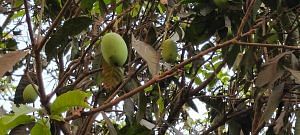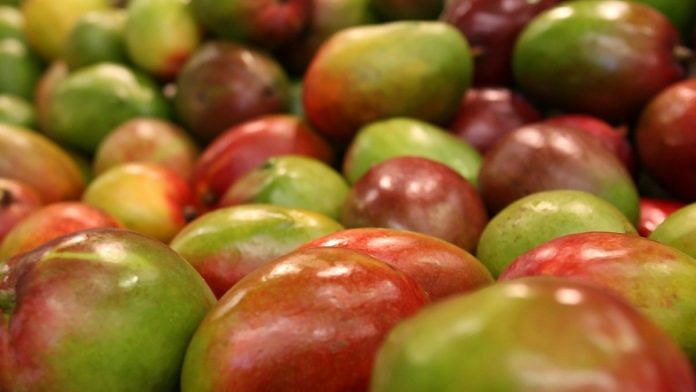Summer in India is redolent of the aroma of ripening mangoes. It evokes the poet among its legion of fans who are prone to fall back on Mirza Ghalib’s couplets romanticising the pulpy fruit. The 18th century Urdu poet deemed the mango sweeter than sugarcane. “Mujhse pucho tumhe khabar kya hai, Aam ke aage neshkar kya hai (Ask me, for what do you know/ a mango is far sweeter than sugarcane)” he wrote in one of his couplets.
But something is rotten with the ‘king of fruits’ this year, one that has cut a swathe of devastation across mango orchards in Bihar and Uttar Pradesh already reeling under fluctuating weather conditions—the red-banded mango caterpillar, which burrows into the skin and flesh to feast on the seed.
Isram Ali, president of the Indian Mango Association, says farmers have never experienced such devastating loss in at least half a century. “Last year, 40 lakh metric tonnes of mango were produced in UP, one of the biggest producers of the fruit in the country. This year production is not expected to touch even 10-12 lakh metric tonnes.”
Also read: In drought-prone Kachchh, Sardar Sarovar project is ‘dream come true’. But not for all farmers
Surviving Covid and nature
The past two years have been tough for mango farmers across India. They weathered pandemic-induced lockdowns and export restrictions in 2020 followed by unseasonal rains last year. This year, their crop was affected by a scorching summer and rapid weather changes. In February, mango trees laden with flowers or ‘manjar’ brought hope to farmers, but within a fortnight the flowers wilted under an unrelenting sun.
In Bihar and Uttar Pradesh, mangoes that did survive the vagaries of weather, were attacked by the red-banded mango caterpillar. Orchard owners in both states estimate that only 15 to 20 per cent of their yield remains unaffected.
Prem Kishor, who owns a mango orchard in Vaishali district, Bihar, is praying for early rains. “In 2020, we harvested only a small portion of the fruit to sell in the local market due to coronavirus. Last year, there was so much rain at the time of fruition that both mango and litchi fruits fell to the ground before they could be harvested. This year, it’s the red caterpillar,” he says.
At each and every orchard ThePrint visited in Bihar and UP, farmers shared a similar story of ruin. “If it does not rain hard within a week, then this pest will ruin us completely this time,” says Ashok Chaudhary, who owns about 400 mango trees spread across 12 acres of land in Bhagalpur, Bihar.
The insects attacked the mango crop just as farmers were preparing to harvest them. “Right now, we cannot even use insecticide spray on them, as insecticides can be poisonous for the fruit and harmful for health”, says Chaudhary, who is chairman of the Bihar Aam Utpadak Sangh (Bihar Mango Growers’ Association).
As a result, mangoes have become more expensive. The Maldah and Jardalu varieties, that are grown in Bihar, are selling for Rs 30-40 per kg in the wholesale market when last year they were going for Rs 20-30 per kg. Muzaffarpur, Vaishali, East Champaran, Darbhanga, Bhagalpur, Patna, Saran and Katihar are among the most prominent mango growing districts in Bihar.

Also read: In 1955, India tried ‘mango diplomacy’ with China. The outcome wasn’t really sweet
Tears of joy to sorrow
Uttar Pradesh is famous for varieties such as Dussehri, Langda, Chausa and Bombay. In Malihabad, Padmashree Kalimullah Khan–who has earned the moniker ‘Mango man’—insists that he has never seen such a bad crop in all his 80 odd years. “The flowering was so good. Orchards were filled with joy. But now only 15 to 20 per cent of that entire crop is left. If an orchard had a 100 mango trees, then the fruit is visible on only 10 to 12 of them,” he says.
Ali of the Indian Mango Association blames the Narendra Modi government for failing to listen to farmers. “The rapidly deteriorating crop is just one of many reasons for the failure of the mango crop. Many duplicate drugs are being supplied in the market; there is no lab for mango fertility testing. Even the scientists are not revealing anything to farmers,” he says.
Many farmers underscore the need to grow younger trees. “One of the reasons for crop failure is that many of the trees are more than a hundred years old, and are not yielding fruit. The forest department is not allowing us to cut them down,” Ali alleges.
Also read: Gandhi cursed ‘luscious’ mangoes he once loved because he wanted to transcend sex & desire
Fickle weather
The national fruit that has graced the tables of emperors, kings and queens over centuries is particularly vulnerable to extreme weather conditions brought about by climate change. Scientists, association members as well as the farmers estimate that there will be a net reduction of 25 to 30 per cent in overall mango production this year.
Dr Feza Ahmed, associate director, research, Bihar Agricultural University, Sabour, explains how weather patterns affected crops this year. “When trees were flowering between January and February, it was very cold. But when it was time for fruition in early March, it suddenly became very hot. Weather continued to fluctuate for about two weeks, and baby mangoes (tikole) took on a yellowish hue, and started falling from the trees,” he says. Other crops were also affected by these sharp fluctuations.
The third reason is lack of water. “We are somehow managing to pour water in the trees’ roots to irrigate them by running the water pumps. This is our last resort to save the crops. This is because it is still too hot and it is devastating our crops,” says Prem Kishor.
Also read: How food prices play out in India this year will depend on global inflation and local rains
Low Kesar yields in Gujarat
The mango (Kesar) belt in Gujarat was not spared either. Vimal Kanabar, a mango orchard owner and trader from the state claims that this season has been the worst in two decades. “Auction for mangoes at local mandis began on April 26. The season usually starts with about 40,000-60,000 boxes of mangoes coming in per day but this year, even during peak summer, we are getting only 5,000 boxes,” he says.
On the first day of the auction, they received barely 3,850 mango boxes. Each box weighs 10 kgs and is priced anywhere between Rs 1,100-14,50. “Till last year, one box was sold for Rs 400-600,” Vimal adds.
Farmers blame the low Kesar yields on the short flowering cycle which was affected by an unexpected change in temperature, and the lingering effects of Cyclone Tauktae that struck Gujarat in May 2021.
“We lost around 70 per cent of mango trees along the Talala-Gir belt. Yield from the remaining trees was very low,” says another farmer from Gujarat.
Maharashtra had a relatively successful, but short season as untimely rain ruined the produce towards the end of the season. According to traders from the region, about 20 to 30 per cent of mangoes were rotten, compared to 15 per cent last year.
Also read: Let farmers lease land like people rent houses – Land laws are holding India back
Mango exports also hit
India produces more than a thousand varieties of mangoes, but only 30 are grown commercially. As per data given by Agriculture and Processed Food Products Export Development Authority (APEDA) India exported 21,033.58 metric tonnes of fresh mangoes to the world for Rs 271.84 crore during the year 2020-21.
While some varieties of mangoes started leaving India’s shores for other countries in April, exporters, especially from Uttar Pradesh, are worried. “Many exporters invest directly in farms and this year they have lost lakhs worth of investment as the trees did not bear fruits. Though we will start exporting mangoes from June onwards, we expect their prices to increase by 20 per cent,” said Shaizad Khan, an exporter from UP.
With inputs by Soniya Agrawal
(Edited by Zoya Bhatti)



